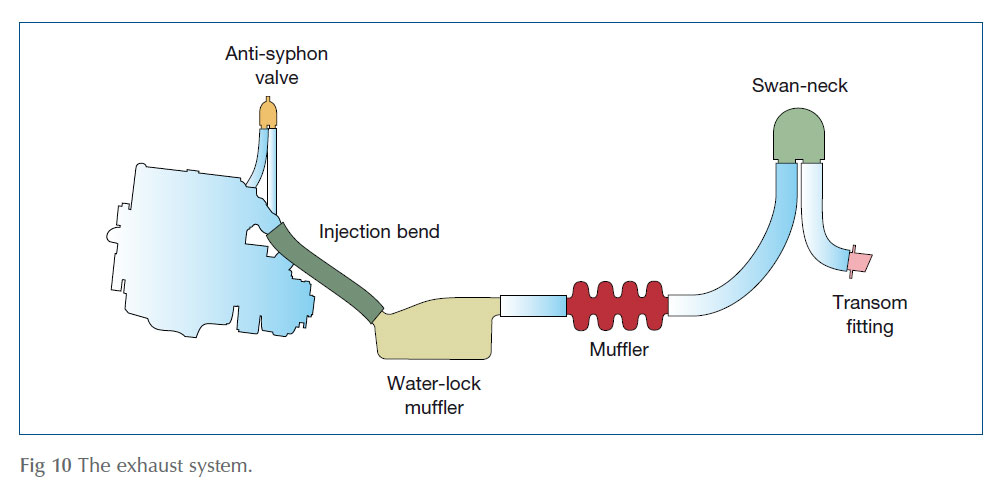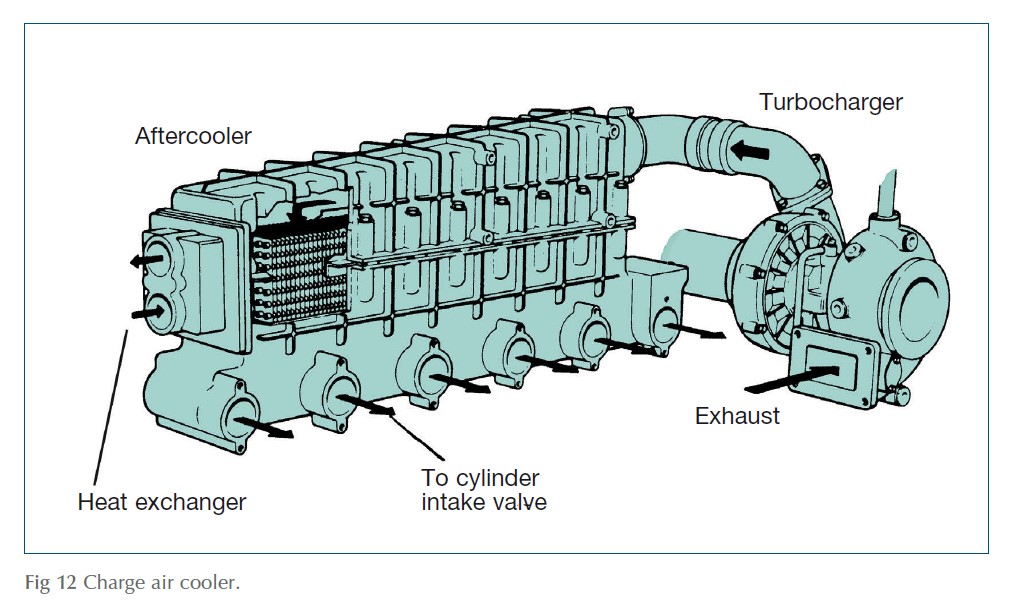Fuel, by itself, is of no use whatsoever: it needs oxygen from the air outside in order to burn. At the most basic level, this happens of its own accord: as the piston falls during the induction stroke, air rushes in past the open inlet valve to fi ll the expanding space. Then, when the compression and power strokes are complete, the exhaust valve opens and the rising piston pushes the exhaust gas out ready for a fresh charge of clean air.
In practice, though, the engine needs an air filter to stop dirt, moisture and bits of rubbish being sucked into its cylinders, and it needs an exhaust system to dispose of the hot exhaust gases safely and quietly. To save having a separate fi lter and exhaust pipe for each cylinder of a multi-cylinder engine, the incoming air is fed to the cylinders through a tubular structure called the inlet manifold, and the exhaust gases are carried away through a similar structure called the exhaust manifold.
Air filters
Unlike their cousins that power tractors and earth-moving machinery, marine diesels usually operate in a relatively clean environ ment: there’s little danger of them having to contend with straw, dust or roadside litter. This means that their air fi lters can be relatively simple, so some engines operate perfectly well for years with little more than a metal box with a few baffl es in it.
Most, however, feature something a little more sophisticated, involving either wire gauze or porous paper.
Paper tends to restrict the air fl ow, so to make up for this its area has to be increased by being folded into a concertina shape. It’s also diffi cult to clean, so once a paper fi lter becomes clogged it has to be replaced with a new one.
Wire gauze doesn’t restrict the air fl ow as much, but it is less effective because the gaps between the strands of wire are bigger than those between the fi bres of paper. To counter this problem – and to minimise corrosion – wire gauze fi lters need to be dipped in oil from time to time, so that dust sticks to them instead of passing straight through.
Exhaust systems
When it comes to exhaust systems, the boot is on the other foot: road vehicles and agricultural machinery have an easy time of it. Their engines are in compartments that are open to the atmosphere but sealed away from their drivers and passengers, so all that’s required is a pipe connected to the exhaust manifold, with a few baffl es to reduce the noise. A few marine installations adopt a similar ‘dry’ exhaust system, usually in the form of an exhaust pipe sticking straight up from the engine compartment, with a weighted fl ap to stop rain or spray running down inside and heat resistant lagging to minimise the risk of fi re or burns.

For pleasure craft, though, ‘wet’ exhausts are pretty well standard, with water from the engine’s cooling system used to cool the exhaust gas. The water is mixed with the exhaust gas in the injection bend, where it almost immediately turns into steam but in doing so reduces the temperature of the exhaust gases from almost 500° C to about 70° C – cool enough to allow flexible tubing and GRP to be used for the rest of the exhaust system.
At that reduced temperature, the steam condenses back into water. That is why the mixing takes place in a bend: it protects the engine against the possibility of the cooling water running back through the system and into the cylinders.
If the engine is below the waterline, or very close to it, however, the injection bend alone is not enough: there’s a danger that water already in the exhaust might set up a siphon effect that would allow sea water from outside to make its way back through the exhaust system and into the engine. To stop this, many boats have an extra loop in the exhaust system, known as a swan-neck. To guard against the possibility of waves pushing water up the exhaust pipe, some boats have a one-way flap covering the end of the pipe where it emerges from the hull; on some sailing yachts you may even find a hand-operated gate valve that seals the exhaust pipe completely when the engine is not being used.
The vital thing about any exhaust system is that it must not restrict the flow of exhaust gases beyond a certain limit, because if the exhaust can’t get out of the cylinders, there will be no room for fresh air to get in. The effect is exactly the same as if the air filter were clogged: starved of oxygen, the engine will not be able to burn its fuel, so it will lose power and produce black smoke.
More power
Any engine is simply a device for converting the energy released from burning fuel into mechanical power. None of them are very good at it: well over 60 per cent of the energy released from the fuel is expended as heat and vibration, rather than as useful mechanical work. Engine designers are continually working to improve efficiency, but the fact remains that the power an engine can produce will always be limited by the rate at which it can burn fuel.

At the present state of development, a good rule of thumb is that every gallon of diesel fuel will produce about 20 hp for one hour – or 10 hp for two hours, or 100 hp for 12 minutes, and so on. So if you want an engine to develop 40 hp, for instance, it needs to burn about 2 gallons per hour.
It’s relatively easy to squirt more fuel into the cylinder, but that alone won’t produce more power, because every gram of fuel needs about 25 g of air in order to burn. So to burn more fuel, you have to get more air into the engine.
This can be achieved in various ways:
- Bigger cylinders This has the advantage of simplicity and relatively low cost.
- More cylinders Involves more complex castings, more valves and a more complicated fuel system, but tends to be smoother-running, and more responsive.
- Run the engine faster This pumps more air through the engine, without increasing its size or weight. Almost all modern diesels run faster than their counterparts of 20 years ago.
- Force air into the cylinders Done by pressurising it, to squeeze the equivalent of about 1¼ litres of air into each 1 litre of cylinder capacity.
The latter option has become very much more popular over the past 20 years or so, and is usually achieved by means of a blower called a turbocharger driven by a turbine built into the engine’s exhaust system.
Unfortunately, turbochargers have to operate at high temperatures and at speeds in the order of 100,000 rpm – which give conservative marine engineers the heebie-jeebies, and produce a high-pitched whine that some people find offensive. Nevertheless, turbochargers are usually very reliable, and coax about 25 per cent more power out of an engine very efficiently, by winning back some of the energy that would otherwise be wasted in flow of hot exhaust gas.

One snag with a turbocharger is that pressurising air, especially by pumping it through a hot component like a turbocharger, raises its temperature; therefore it tries to expand – exactly the opposite of what the turbocharger is trying to achieve! To overcome this, many engines draw their air supply through a duct lined with pipes containing cool sea water called a charge air cooler, intercooler or aftercooler.
You can get some idea of how effective this is by looking at the specifications of an engine such as the 90 hp Mermaid Melody. With a turbocharger, the same engine becomes the 160 hp Turbo Melody; and with an intercooler as well, it’s up to 200 hp – a 122 per cent increase in power for a 3 per cent increase in weight and 40 per cent increase in price.
Variations on turbocharging
One application for which a turbocharged engine is not suitable is in a boat that spends most of its life operating at low speeds with only occasional, widely spaced bursts of high power. This is because at low power the exhaust flow won’t be enough to operate the turbocharger. Exhaust gas flowing past the stationary turbocharger blades produces a build-up of soot, so when high power is called for, the clogged-up turbocharger can’t work properly. As a result, the engine won’t receive enough air to burn its fuel properly, so it will produce more oily soot that makes matters even worse.
There are various ways in which designers have brought the benefits of turbocharging to engines that have to operate at a wide range of speeds.
One method is to fit a smaller turbocharger, capable of operating even with the reduced flow of exhaust gas produced at low engine speeds. This, however, means that at high revs the turbocharger will be faced with more exhaust than it can cope with, so some of the exhaust has to be diverted away through a bypass arrangement called a waste-gate.
An alternative is to use a mechanically driven compressor called a supercharger at medium revs, allowing the turbocharger to take over as the engine speed increases.
Things to do
1. BLACK SMOKE
Black smoke is almost certainly a symptom of problems in the air system.
- a. Check to make sure that the engine room ventilation is adequate – that the engine compartment ventilation louvres aren’t blocked by leaves or by the contents of lockers, for instance – and that the engine’s air filter isn’t clogged.
- b. On turbocharged engines, look for loose hoses or leaks between the turbocharger and the engine itself.
- c. Make sure the exhaust hose isn’t blocked, squashed or damaged: bear in mind that flexible exhaust pipes can deteriorate in time, allowing their inner layers to collapse while the outside looks perfectly sound.
2. AIR FILTER
- a. Clean or replace the air filter at least once a season. Unclip or unscrew the cover, and lift out the filter element. Paper elements should be replaced if they are dirty or damaged.
- b. Wire gauze filters should be washed in paraffin or a solution of washing-up liquid in water, and allowed to dry. Inspect the filter for rust or loose strands, and replace it if necessary. Otherwise, dip it in clean engine oil and drain off the excess.
References
Adlard Coles Book of Diesel Engines

